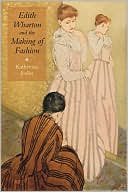

 |

|

The average rating for Edith Wharton and the Making of Fashion based on 2 reviews is 3 stars.
Review # 1 was written on 2010-12-16 00:00:00 Carlos Cox Carlos Cox"It is a strange experience for a literary scholar... to research actual garments and to literally read dress," reflects Katherine Joslin in Edith Wharton and the Making of Fashion. But this exactly what the professor of English does by examining turn of the century gowns at the Metropolitan Museum of Art's Costume Institute. Most studies of Wharton, celebrated for her intricately detailed novels of Gilded Age New York such as The House of Mirth and The Age of Innocence, banish fashion to the footnotes, if not ignoring it altogether. "Scholars live in a world that valorizes the mind and looks askance at a well-clad body," Joslin explains. "Perhaps that is why we have shied away from the glamour of fashion." She argues that moving fashion to the foreground gives us a more complete view of Wharton and her work. The writer loved clothing, painstakingly dressing herself and her characters. Her novels were often concerned with society's unspoken codes and rules, and clothing was essential to her portrayal a character's social position and inner being. As Joslin puts it, Wharton recognized that "the choosing of fabric, the draping of a dress, and veiling of a hat reveal more than they conceal... Wharton sees the subtle shades of fabric and fabrication." Alongside the wardrobes of Wharton's heroines (who often examine themselves in mirrors, allowing the writer and reader to join in the character's evaluation), Joslin investigates her treatment of seamstresses and textile industry in lesser-read stories. Joslin puts Wharton's writing into context by providing condensed histories of the French couture houses and American department store culture, two revolutionary forces in the fashion of the time. What makes Joslin's study stand out is her use of non-traditional primary sources such as illustrations, photographs, and items of clothing. She links the illustrations that originally accompanied The House of Mirth with the era's famed Gibson Girl, whose active lifestyle was never hindered by a tight corset, an incongruity that bothered Wharton. Joslin observes that "the heroines of her fiction suffer the misconception that a culture that would tightly lace the body would offer freer social movement." Photographs of Wharton herself are also analyzed, such as one of the author at her desk, supposedly writing in an elaborate evening gown, and these are contextualized with anecdotes from her life. We learn of her failed attempt to befriend fellow writer Henry James by arriving at a party in a pretty gown "of tea-rose pink, embroidered with iridescent beads." Ultimately, it was her writing, not her clothing, that sealed their life-long friendship. Close examinations of Wharton's contemporaries' clothing allow Joslin to make the kind of detailed observations that had this reader continuously flapping back to previous pages for second looks. Although none of Wharton's own clothing has survived, detailed photographs of outfitted mannequins help the reader visualize Wharton running her hands along Venetian lace, or selecting the perfect pointed shoe. Having only read half of the novels discussed, I can say that a prior knowledge of Wharton's writing is not required to enjoy this book, and those interested in 19th and early 20th century fashions will find much of interest. Most importantly, by showing us a Doucet evening gown, a tweedy riding jacket and a hat adorned with an entire stuffed bird, Joslin demonstrates that material culture should have an acknowledged place in literary criticism.(reviewed by Max Mosher) |
Review # 2 was written on 2010-10-10 00:00:00 Gerry Mcguire Gerry McguireI read this book for my Material Culture class. I liked it but I have not read any Edith Wharton novels and I got lost at some parts with Joslin's references to her work. However, there is a lot of great information about late 19th century and early 20th century fashion and some awesome pictures. It is a good read especially for the fashionista. |
CAN'T FIND WHAT YOU'RE LOOKING FOR? CLICK HERE!!!